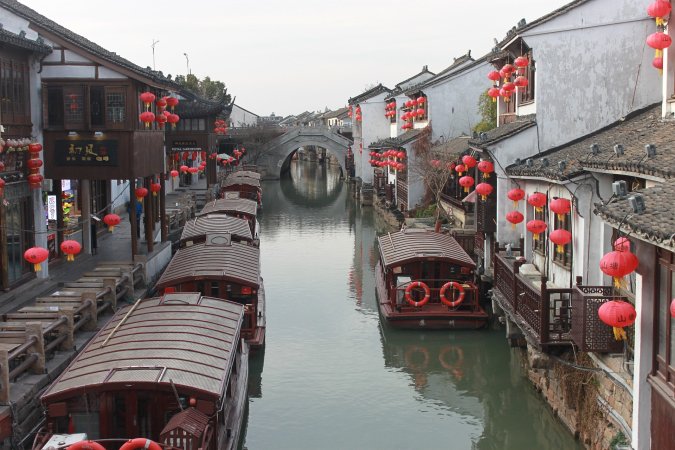Ancient City of Suzhou

Geographical area: Asia and the Pacific
Location: Suzhou, China
City size: XL (above 5,000,000 inhabitants)
Promoter: Municipality of Suzhou
Developer: Municipality of Suzhou and private developers
Start year:
End-year:
Implementation phase: Completed
Project size: Neighborhood
Total area of intervention (in sqm): 14.200.000
Total investments (in USD): 641.9 million
The Ancient City renovation project was conducted by the Municipality of Suzhou covering the 54 neighborhoods of the ancient city of Suzhou. The old neighborhoods of Suzhou retain centuries of the city's heritage and history. However, the neighborhood was not prepared to absorb the rapid population and economic growth experienced during the 1980s. The enormous growth needed rapid urban extension and infrastructural improvements throughout the ancient city. The ancient city neighborhoods suffered from poor-quality infrastructures, a lack of services, a congested road network, and an insufficient supply of water, power, and sewage services. In addition, the neighborhood was heavily polluted due to the presence of high-polluting factories and the absence of green areas. The redevelopment initiative started in 1992 when the Municipality of Suzhou developed an ambitious plan to renovate the housing stock, restore the historical buildings, and avoid damaging the architectural and cultural heritage of the old neighborhoods. The entire housing stock and land site involved in the project were entirely owned by the Municipality of Suzhou. During the planning phase, the Municipality of Suzhou developed a clear masterplan for the intervention, setting out the priorities and a step-by-step approach to implement the different project phases. The masterplan has been developed by collaborating with experts, citizens, private developers, and local authorities, with the support of a special planning commission and advisory committee. The construction works and the implementation of the project were conducted by private developers, including local, national and international real estate developers, enterprises, associations, and citizens. The redevelopment initiative benefitted from public funds of the Municipality of Suzhou and investments from private companies and residents. The redevelopment focused on repopulating and improving the living conditions of the ancient neighborhood of the city. The project successfully restored the deteriorated and outdated housing stock in the old neighborhoods and improved the water and gas supplies, sewage disposal system, public infrastructures, services, and telecommunications. The project also increased the urban green areas available for the residents and improved the environmental quality of the inner city by ameliorating water quality and relocating polluting factories. The completion of the project provided local communities with renovated housing units and improved public services, creating a more sustainable and livable neighborhood. These major improvements in the living conditions brought important economic benefits in terms of employment and business opportunities for the local community. Lastly, the initiative restored the ancient buildings to preserve the historical and cultural heritage of the city.
Land use zoning
The project focused mainly on the renovation and creation of residential buildings and the conservation of the environment, creating open spaces and green areas for recreational and leisure activities. The redevelopment initiative dedicated part of the renovated area to community services and facilities, such as schools and recreational centers, and to commercial and professional activities spaces.
Economic
The restoration of the ancient inner city helped to foster the local economic development of the neighborhood and the whole city. The restoration of the ancient and historical buildings increased the attractiveness of the city and boosted the influx of tourists, strengthening the city's position as a popular touristic destination in the country and attracting 16 million tourists per year as of 2001. Secondly, the large public investment for the conservation and renovation works brought new employment and businesses opportunities for the residents. The project created job opportunities directly in the renovation projects and allowed the development of a specialized class of professionals and artisans connected with the conservation and restoration activities.
Environmental
The infrastructural improvements in the city water supply, sewage network, power and gas supply, and telecommunications significantly improved the living conditions in the old neighborhood and created a more sustainable and resilient community. The redevelopment of the site significantly improved water quality and reduced pollution by closing and relocating more than 140 polluting factories. To further improve mitigation efforts, the project increased urban green spaces from 4.66 to 26.4 square km and created a green belt around the inner city.
Social
Certificates
The projects received the LEED Silver Certification for the E+H Suzhou Project.
Funding source
The projects had been conducted following a public-private partnership, as the redevelopment had been funded employing both public and private resources. The financial resources came in major part from direct funds of the Municipality of Suzhou, and from private investments of private developers, companies and citizens.
Financing and economic instruments
The project received direct grants from the Municipality of Suzhou, as well as private investments and funding from residents and companies. The organizations that provided funds for the redevelopment projects are the Construction Group, Jianye Real Estate, Panmen Travel Development and Guanqian Construction Development. In addition to public grants and private investments, the project relied on bank loans and foreign direct investments (FDI). The Municipality of Suzhou introduced also tax-based incentives, reduced tariffs and lowered fees for the households involved in the housing renovation. For families that opted for moving to newly built housing the Municipality opted for two different types of incentives: a one-time grant of free housing equivalent to 3 sqm per person, and a 14% discount on the price of the new housing. For the households remaining in the old neighborhood, the Municipality provided subsidies for those repair works aimed at improving services, infrastructure and livability of the unit. Lastly, the subsequent phases of redevelopment were financed also by reinvesting the profits generated from the allocation of real estate development rights.